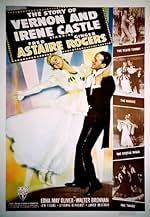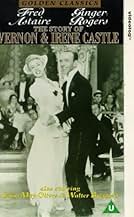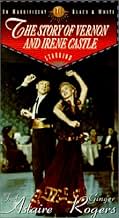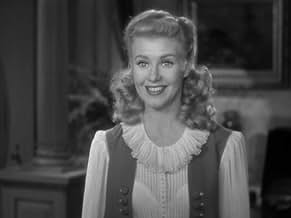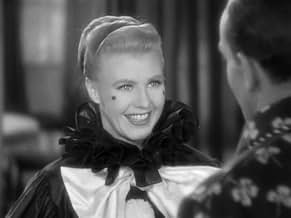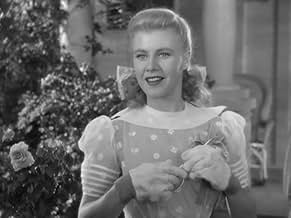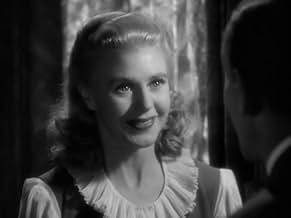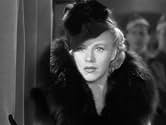La vida de Irene y Vernon Castle
Título original: The Story of Vernon and Irene Castle
CALIFICACIÓN DE IMDb
6.9/10
2.9 k
TU CALIFICACIÓN
La historia del matrimonio de Irene y Vernon Castle, sensacionales bailarines de salón antes de la Primera Guerra Mundial.La historia del matrimonio de Irene y Vernon Castle, sensacionales bailarines de salón antes de la Primera Guerra Mundial.La historia del matrimonio de Irene y Vernon Castle, sensacionales bailarines de salón antes de la Primera Guerra Mundial.
- Dirección
- Guionistas
- Elenco
- Premios
- 4 premios ganados y 1 nominación en total
Buzz Barton
- Undetermined Secondary Role
- (sin créditos)
Max Barwyn
- Waiter - Cafe de Paris
- (sin créditos)
Opiniones destacadas
Here's one of those rare films that I like where there are no villains, just a nice, old-fashioned story with good people.
Of all the Fred Astaire-Ginger Rogers films, I would guess this gets the least amount of publicity and if that's true, it's a shame.
There are plenty of dance scenes in here. I prefer the tap dancing to ballroom, but that's just my personal tastes. The famous dancing duo are great with any style. I like Walter Brennan, so it's nice to see him in this film and it also was nice to see Edna May Oliver play a nice character, for a change.
The only complaint was the ending was so predictable. You see it coming a mile away. How true this story is, I can't say, but overall it's one of my favorite Astaire-Rogers movies. I am sorry it gets so little attention.
Of all the Fred Astaire-Ginger Rogers films, I would guess this gets the least amount of publicity and if that's true, it's a shame.
There are plenty of dance scenes in here. I prefer the tap dancing to ballroom, but that's just my personal tastes. The famous dancing duo are great with any style. I like Walter Brennan, so it's nice to see him in this film and it also was nice to see Edna May Oliver play a nice character, for a change.
The only complaint was the ending was so predictable. You see it coming a mile away. How true this story is, I can't say, but overall it's one of my favorite Astaire-Rogers movies. I am sorry it gets so little attention.
The Story of Vernon and Irene Castle is the last of the 9 RKO musicals Astaire did with Rogers. However, from a story point-of-view, it is their best film by a mile. The contest isn't even close, IMO.
It's not their best musical. This film is really a drama with a few musical interludes, whereas most of the other Astaire-Rogers films were musical comedies. Those other films had flimsy plots at best and were saved only by their songs and dances. BUT - "Vernon and Irene" could easily stands alone without any songs or dances. It even has some action sequences as is typical of war-time films (WWI, in this case).
The film is a bio-pic about the Castles, who in their heyday were even bigger than Astaire and Rogers. The choreography is more attuned to 1910's sensibilities than the usual Astaire and Rogers film, but that's okay. Astaire and Rogers dance just well as always.
As the dancing duo's last RKO film, V&C is quite classy and a fine close to a great RKO dancing career for the two.
It's not their best musical. This film is really a drama with a few musical interludes, whereas most of the other Astaire-Rogers films were musical comedies. Those other films had flimsy plots at best and were saved only by their songs and dances. BUT - "Vernon and Irene" could easily stands alone without any songs or dances. It even has some action sequences as is typical of war-time films (WWI, in this case).
The film is a bio-pic about the Castles, who in their heyday were even bigger than Astaire and Rogers. The choreography is more attuned to 1910's sensibilities than the usual Astaire and Rogers film, but that's okay. Astaire and Rogers dance just well as always.
As the dancing duo's last RKO film, V&C is quite classy and a fine close to a great RKO dancing career for the two.
The great irony here is that today, if the professional dancing team of Vernon and Irene Castle is remembered at all, it is because Fred Astaire and Ginger Rogers played them in a movie. Plus,many people don't like "The Story of Vernon and Irene Castle", and just find it lacking something. This is probably because there is virtually no romantic conflict between the two in this film. Astaire & Rogers spend practically the entire film either allied or happily married. Because the two are happily married in the film, you're missing all of the fun of the misunderstandings, squabbling, and sexual tension of their other RKO starring vehicles. The conflict is first economic and professional as the pair struggled to get recognized as great dancers, and then there is World War I in which Vernon Castle, as an English native, feels compelled to enlist. The film is quite good, but it is very sentimental and atypical of Astaire & Rogers' other films. This was intended to be the pair's last film together, and was their last film together at RKO. It was just a series of accidental recasting decisions that led them to reunite in "The Barkleys of Broadway" at MGM ten years later, which was a big splash musical in the big splashy MGM tradition, quite different from their earlier films together.
There is one hilarious goof in this delightful film. When Irene and Vernon are having dinner in the Parisian restaurant in which they are to make their debut Irene is wearing her wedding dress as they are too broke to afford to buy her a new evening dress, She is also wearing a little lacy winged hat of the type worn in the national costume of Holland.
In England there were gales of laughter when Irene says "I feel just like a bride again in my wedding dress and my little Dutch cap." In the UK a Dutch cap is a female contraceptive device which I believe is called a "diaphragm" in USA.
In England there were gales of laughter when Irene says "I feel just like a bride again in my wedding dress and my little Dutch cap." In the UK a Dutch cap is a female contraceptive device which I believe is called a "diaphragm" in USA.
"Castles in the Air" is the title of Irene's 1958 autobiography but it's also an apt summarization of this robust, poignant tale. Vernon and Irene Castle were far more famous and influential in their day than Fred Astaire or Ginger Rogers were later, though they are less remembered now.
This movie pays glorious tribute to the Castles and their dance repertoire which Astaire and Rogers beautifully replicate. The crazy maze of fame that swirled around the young couple, their great love for each other and their private travail, are sensitively presented. The supporting cast includes the always superb Walter Brennan as the Castles' chaperone-servant, and Edna May Oliver as their agent, a take-off on real-life Elisabeth (Bessy) Marbury. Producer Lew Fields, who gave Vernon Castle his first job on the New York stage, makes a cameo appearance.
Although Irene Castle served as technical advisor and assisted Walter Plunkett with costuming, there were polite clashes on the set (and off) between her and Ginger Rogers who objected, most notably, to Irene's insistence that she dye her hair dark and cut it short to more accurately resemble her. For those familiar with Irene Castle, whose extraordinary looks (particularly the bobbed hair-style she introduced) were so much a part of her image, they will understand Irene's dissatisfaction with long-tressed, blonde Rogers. It says much for Ginger Rogers' capabilities that the story is not hindered by this departure from authenticity (more glaring then than today).
A NOTE ON COSTUMES:
This film gives some idea of Irene's popularity as a fashion trendsetter which was tremendous in the 1910s and 20s. In fact, many of the stunning gowns Ginger Rogers wears are quite faithful adaptations of costumes designed by Lucile (Lady Duff-Gordon) for Irene Castle during her Broadway and silent-movie days. Ginger's dress with the handkerchief hem and huge chiffon sleeves (double-banded in fur) was copied from the original which Irene wore for the premiere of Irving Berlin's "Watch Your Step" in 1914. This original, by Lucile, is now at the Costume Institute of the Metropolitan Museum of Art. A black and white evening gown, a pleated silk day dress, and a striped travelling suit are other Lucile designs reproduced by Plunkett for Rogers in this picture.
This movie pays glorious tribute to the Castles and their dance repertoire which Astaire and Rogers beautifully replicate. The crazy maze of fame that swirled around the young couple, their great love for each other and their private travail, are sensitively presented. The supporting cast includes the always superb Walter Brennan as the Castles' chaperone-servant, and Edna May Oliver as their agent, a take-off on real-life Elisabeth (Bessy) Marbury. Producer Lew Fields, who gave Vernon Castle his first job on the New York stage, makes a cameo appearance.
Although Irene Castle served as technical advisor and assisted Walter Plunkett with costuming, there were polite clashes on the set (and off) between her and Ginger Rogers who objected, most notably, to Irene's insistence that she dye her hair dark and cut it short to more accurately resemble her. For those familiar with Irene Castle, whose extraordinary looks (particularly the bobbed hair-style she introduced) were so much a part of her image, they will understand Irene's dissatisfaction with long-tressed, blonde Rogers. It says much for Ginger Rogers' capabilities that the story is not hindered by this departure from authenticity (more glaring then than today).
A NOTE ON COSTUMES:
This film gives some idea of Irene's popularity as a fashion trendsetter which was tremendous in the 1910s and 20s. In fact, many of the stunning gowns Ginger Rogers wears are quite faithful adaptations of costumes designed by Lucile (Lady Duff-Gordon) for Irene Castle during her Broadway and silent-movie days. Ginger's dress with the handkerchief hem and huge chiffon sleeves (double-banded in fur) was copied from the original which Irene wore for the premiere of Irving Berlin's "Watch Your Step" in 1914. This original, by Lucile, is now at the Costume Institute of the Metropolitan Museum of Art. A black and white evening gown, a pleated silk day dress, and a striped travelling suit are other Lucile designs reproduced by Plunkett for Rogers in this picture.
¿Sabías que…?
- TriviaIrene Castle served as a technical advisor on the film. According to Ginger Rogers, Castle disliked every costume she wore and deemed them anachronistic. Due to censorship restrictions, Rogers' costumes evoked late 1930s fashions rather than the more daring styles of Castle's 1910s era. After Rogers refused to bob her hair to portray the hairstyle that Irene had popularized, Castle became more displeased. The studio silenced Castle's protests with an additional payment of $5,000.
- ErroresThe film erroneously depicts the Castles touring with white orchestras. In actuality, Vernon and Irene Castle always toured with a black orchestra; specifically, James Reese Europe's Society Orchestra.
- Citas
Irene Castle: I thought you could be a first dancer, a very beautiful first dancer because you are a beautiful dancer but you're so smug and conceited that you can't see any further than your funny nose!
- ConexionesFeatured in Fred Astaire: Puttin' on His Top Hat (1980)
- Bandas sonorasOnly When You're in My Arms
(1939)
by Con Conrad - Herman Ruby Bert Kalmar
Sung by Fred Astaire (uncredited)
End dance: Fred Astaire (uncredited) and Ginger Rogers (uncredited)
Selecciones populares
Inicia sesión para calificar y agrega a la lista de videos para obtener recomendaciones personalizadas
- How long is The Story of Vernon and Irene Castle?Con tecnología de Alexa
Detalles
- Fecha de lanzamiento
- País de origen
- Idioma
- También se conoce como
- The Story of Vernon and Irene Castle
- Locaciones de filmación
- Productora
- Ver más créditos de la compañía en IMDbPro
Taquilla
- Presupuesto
- USD 1,196,000 (estimado)
- Tiempo de ejecución1 hora 33 minutos
- Color
- Relación de aspecto
- 1.37 : 1
Contribuir a esta página
Sugiere una edición o agrega el contenido que falta

Principales brechas de datos
By what name was La vida de Irene y Vernon Castle (1939) officially released in Canada in English?
Responda
